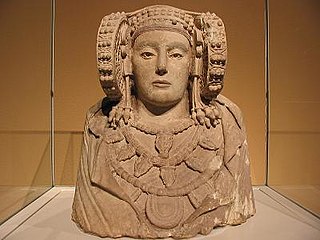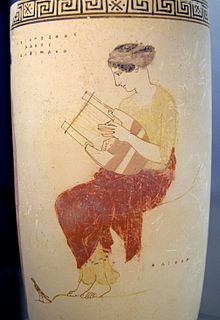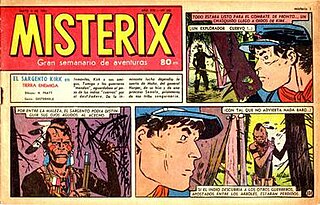El Jabato (lit. "The young wild boar") is the hero of a series of Spanish comic books, created in 1958 by the writer Víctor Mora and illustrated mainly by Francisco Darnís. El Jabato's themes and cast of characters were similar to those of the other series created by Mora, Capitán Trueno , although El Jabato is set in ancient Rome, while Capitán Trueno was a knight-errant of the Middle Ages.

Spain, officially the Kingdom of Spain, is a country mostly located in Europe. Its continental European territory is situated on the Iberian Peninsula. Its territory also includes two archipelagoes: the Canary Islands off the coast of Africa, and the Balearic Islands in the Mediterranean Sea. The African enclaves of Ceuta, Melilla, and Peñón de Vélez de la Gomera make Spain the only European country to have a physical border with an African country (Morocco). Several small islands in the Alboran Sea are also part of Spanish territory. The country's mainland is bordered to the south and east by the Mediterranean Sea except for a small land boundary with Gibraltar; to the north and northeast by France, Andorra, and the Bay of Biscay; and to the west and northwest by Portugal and the Atlantic Ocean.

A comic book or comicbook, also called comic magazine or simply comic, is a publication that consists of comic art in the form of sequential juxtaposed panels that represent individual scenes. Panels are often accompanied by brief descriptive prose and written narrative, usually, dialog contained in word balloons emblematic of the comics art form. Although comics has some origins in 18th century Japan, comic books were first popularized in the United States and the United Kingdom during the 1930s. The first modern comic book, Famous Funnies, was released in the U.S. in 1933 and was a reprinting of earlier newspaper humor comic strips, which had established many of the story-telling devices used in comics. The term comic book derives from American comic books once being a compilation of comic strips of a humorous tone; however, this practice was replaced by featuring stories of all genres, usually not humorous in tone.
Víctor Mora was a Spanish comic book writer.
El Jabato concerns the adventures of two Iberian warriors, El Jabato and a giant, gluttonous sidekick, Taurus, who are taken from their native lands by the invading Roman armies. A third character (the girl), named Claudia, a Roman girl who eventually embraces Christianity, is also introduced in the first issue of the series.

The Iberians were a set of people that Greek and Roman sources identified with that name in the eastern and southern coasts of the Iberian peninsula, at least from the 6th century BC. The Roman sources also use the term Hispani to refer to the Iberians.

In historiography, ancient Rome is Roman civilization from the founding of the Italian city of Rome in the 8th century BC to the collapse of the Western Roman Empire in the 5th century AD, encompassing the Roman Kingdom, Roman Republic and Roman Empire until the fall of the western empire. The civilization began as an Italic settlement in the Italian Peninsula, conventionally founded in 753 BC, that grew into the city of Rome and which subsequently gave its name to the empire over which it ruled and to the widespread civilisation the empire developed. The Roman empire expanded to become one of the largest empires in the ancient world, though still ruled from the city, with an estimated 50 to 90 million inhabitants and covering 5.0 million square kilometres at its height in AD 117.
Christianity is a religion based on the life and teachings of Jesus of Nazareth, as described in the New Testament. Its adherents, known as Christians, believe that Jesus Christ is the Son of God and savior of all people, whose coming as the Messiah was prophesied in the Old Testament.
A fourth character was subsequently added. This was Fideo de Mileto (Phideus of Miletus), a very minor Greek poet who torments Taurus with his endless verses, with which he narrates the adventures of his friends. Fideo carries a lyre (which Taurus has attempted to destroy more than once), and fights his enemies with his musical powers. Even later, more characters were added: a boy named Tai-Li, a tiger named Bambú, and a monkey named Bongo.

Miletus was an ancient Greek city on the western coast of Anatolia, near the mouth of the Maeander River in ancient Caria. Its ruins are located near the modern village of Balat in Aydın Province, Turkey. Before the Persian invasion in the middle of the 6th century BC, Miletus was considered the greatest and wealthiest of Greek cities.

Ancient Greece was a civilization belonging to a period of Greek history from the Greek Dark Ages of the 12th–9th centuries BC to the end of antiquity. Immediately following this period was the beginning of the Early Middle Ages and the Byzantine era. Roughly three centuries after the Late Bronze Age collapse of Mycenaean Greece, Greek urban poleis began to form in the 8th century BC, ushering in the Archaic period and colonization of the Mediterranean Basin. This was followed by the period of Classical Greece, an era that began with the Greco-Persian Wars, lasting from the 5th to 4th centuries BC. Due to the conquests by Alexander the Great of Macedon, Hellenistic civilization flourished from Central Asia to the western end of the Mediterranean Sea. The Hellenistic period came to an end with the conquests and annexations of the eastern Mediterranean world by the Roman Republic, which established the Roman province of Macedonia in Roman Greece, and later the province of Achaea during the Roman Empire.

The lyre is a string instrument known for its use in Greek classical antiquity and later periods. The lyre is similar in appearance to a small harp but with distinct differences. In organology, lyres are defined as "yoke lutes", being lutes in which the strings are attached to a yoke that lies in the same plane as the sound-table and consists of two arms and a cross-bar.
The series was immensely popular in Spain, especially during the time of the dictatorship. The main series had an uninterrupted run for 381 issues, before it was affected by the Spanish comic-book crisis that eventually affected all Spanish titles. In addition to the main series another magazine (El Jabato Extra) run for 51 issues plus one special. El Jabato also had an additional series of adventures published inside the magazine "El Capitán Trueno Extra", between the issues 176 and 333.
In 1989 it was adapted into a video game.



